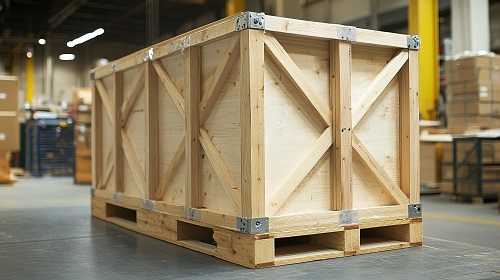In an era where environmental consciousness drives business decisions and consumer choices, the logistics industry faces mounting pressure to adopt sustainable practices. While plastic packaging and synthetic materials have dominated shipping for decades, a growing number of companies are rediscovering the remarkable environmental advantages of wooden shipping crates. These time-tested packaging solutions offer a compelling combination of durability, sustainability, and ecological responsibility that aligns perfectly with today's green commerce initiatives.
The Renewable Resource Advantage
Unlike petroleum-based plastics or metal containers that require energy-intensive extraction and processing, wooden crates originate from forests that can be sustainably managed and continuously regenerated. Trees absorb carbon dioxide throughout their growth cycle, effectively sequestering carbon that would otherwise contribute to atmospheric greenhouse gases. When these trees are harvested responsibly and transformed into shipping crates, they continue to store this captured carbon throughout their useful life.
The renewable nature of wood means that properly managed forests can provide a continuous supply of raw materials without depleting natural resources. Modern forestry practices emphasise selective harvesting, reforestation, and biodiversity preservation, ensuring that wood-based products like shipping crates can be produced indefinitely without environmental degradation. This cyclical sustainability model contrasts sharply with finite resources like petroleum or metals, which become increasingly scarce and environmentally costly to extract over time.
Reusability and Durability
The natural strength and resilience of properly constructed wooden crates allow them to withstand repeated handling, stacking, and transportation stresses that might damage or compromise alternative packaging materials. This durability translates directly into environmental benefits by maximising the useful life of each container and reducing the frequency of replacement.
The reusability factor becomes particularly significant when considering the total environmental impact per shipping cycle. A wooden crate that serves reliably for dozens of shipments distributes its environmental production cost across many uses, resulting in a lower per-shipment environmental footprint compared to single-use alternatives. Many industries have embraced returnable wooden crate systems, where containers circulate between suppliers and customers, maximising utilisation and minimising waste generation.
To fully realise these durability and reusability benefits, businesses should prioritise sourcing their wooden crate packaging from reliable and trusted manufacturers who understand proper construction techniques and quality standards, ensuring that each container can withstand the rigours of multiple shipping cycles while maintaining structural integrity.
Biodegradability and End-of-Life Benefits
Perhaps the most significant environmental advantage of wooden shipping crates lies in their natural biodegradability. When these containers reach the end of their useful life, they decompose naturally without leaving harmful residues or requiring specialised disposal facilities. This biological breakdown process returns organic nutrients to the soil ecosystem, supporting plant growth and maintaining healthy soil composition.
The biodegradation timeline for wooden crates varies depending on environmental conditions, but typically occurs within several years when exposed to moisture and natural decomposition agents. This natural recycling process eliminates the long-term environmental burden associated with plastic containers, which can persist in landfills and natural environments for hundreds of years. Even when wooden crates are disposed of in landfills, they contribute to soil improvement rather than creating permanent waste accumulation.
Furthermore, wooden crates can be composted or used as biomass fuel, providing additional end-of-life value that extends their environmental benefits. This versatility in disposal and repurposing options makes wooden shipping containers an increasingly attractive choice for environmentally conscious businesses seeking to minimise their waste footprint.
Energy Efficiency in Production
The manufacturing process for wooden shipping crates requires significantly less energy compared to plastic or metal alternatives. Wood processing typically involves basic cutting, shaping, and assembly operations that can be accomplished with relatively simple machinery and minimal energy input. The natural properties of wood also allow for efficient fabrication without the high-temperature processing, chemical treatments, or complex manufacturing procedures required for synthetic materials.
This energy efficiency extends to transportation as well, since wood processing facilities can often be located closer to forest resources, reducing the carbon footprint associated with raw material transport. Local and regional wood suppliers can provide materials for crate manufacturing, supporting shorter supply chains and reduced transportation emissions. The decentralised nature of wood availability contrasts favourably with the concentrated production centres typical of plastic and metal manufacturing, which often require long-distance shipping of raw materials and finished products.
Supporting Carbon Sequestration
Wooden shipping crates contribute to long-term carbon sequestration by maintaining captured carbon in a stable form throughout their service life. The carbon absorbed by trees during growth remains locked within the wood structure, effectively removing it from the atmospheric carbon cycle for the duration of the crate's existence. This extends beyond the tree's natural lifespan, providing ongoing environmental value that continues well beyond the forest harvesting phase.
When businesses choose wooden shipping crates, they effectively become participants in carbon storage initiatives, helping to mitigate climate change through their routine logistics operations. This passive environmental contribution occurs automatically without requiring additional effort or investment beyond the initial choice of packaging material.
Conclusion
The environmental benefits of wooden shipping crates extend far beyond simple biodegradability, encompassing renewable resource utilisation, energy-efficient production, carbon sequestration, and exceptional reusability. As businesses increasingly prioritise sustainable practices and consumers demand environmentally responsible products, these containers emerge as a practical solution that delivers both operational effectiveness and ecological responsibility.


































